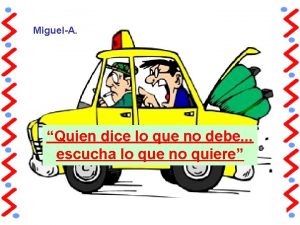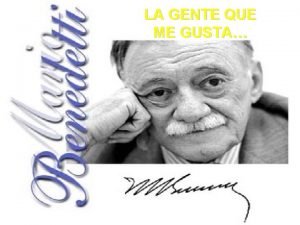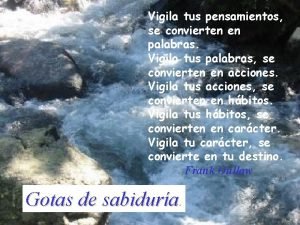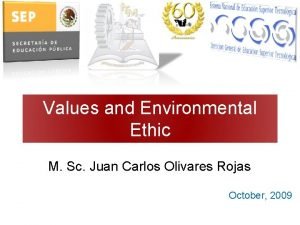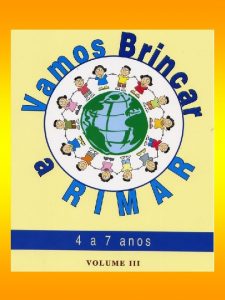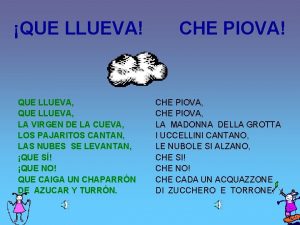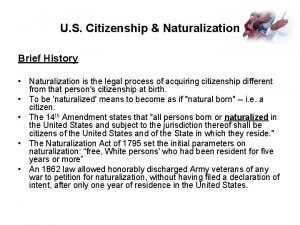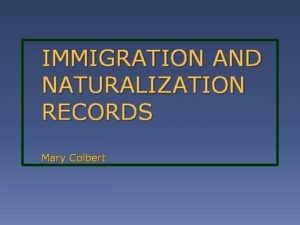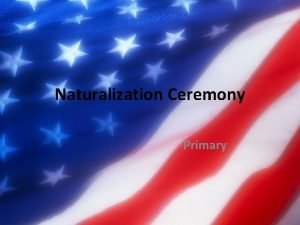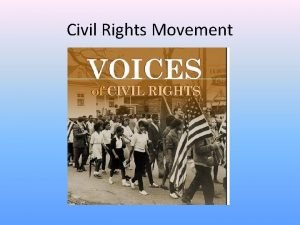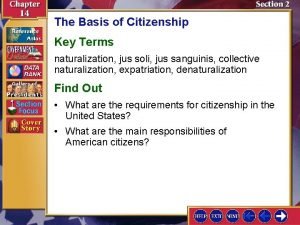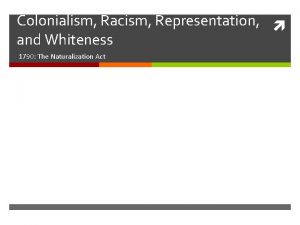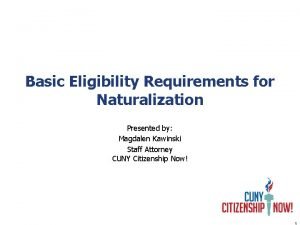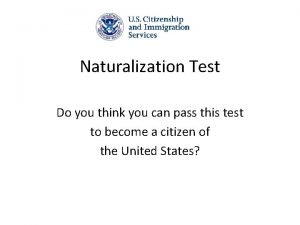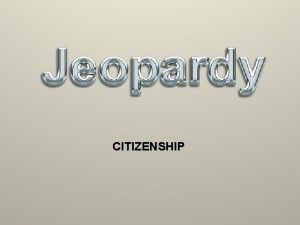WHAT IS NATURALIZATION QUE ES LA NATURALIZACIN Naturalization















- Slides: 15

WHAT IS NATURALIZATION? ¿QUE ES LA NATURALIZACIÓN? • Naturalization is the manner in which a person not born in the United States voluntarily becomes a U. S. citizen. • La naturalización es la forma en que una persona no nacido en los Estados Unidos se convierte voluntariamente en ciudadano de los EE. UU.

WHO CAN BECOME A U. S CITIZEN TROUGH NATURALIZATION? • Permanent residents (Green Card holders) who have lived in the United States continuously for 5 years. • Spouses of U. S. citizens that have been permanent residents for 3 years. • Residentes permanentes (titulares de la tarjeta verde) que han vivido en los Estados Unidos continuamente durante 5 años. • Individuals who have honorable service in the U. S. military. • Cónyuges de ciudadanos de EE. UU. que han sido residentes permanentes durante 3 años. • Children (under 18 and unmarried) of U. S. citizens. • Individuos que tienen un servicio honorable en el ejército de los EE. UU. • Niños (menores de 18 años y solteros) de ciudadanos estadounidenses.

GENERAL REQUIREMANTS REQUERIMIENTOS GENERALES • Be at least 18 years old at the time of filing Form N-400, Application for Naturalization. • Tener al menos 18 años de edad al momento de presentar el Formulario N-400, Solicitud de Naturalización. • Be a permanent resident (have a “Green Card”) for at least 5 years. • Ser un residente permanente (tener una "Tarjeta verde") durante al menos 5 años. • Show that you have lived for at least 3 months in the state or USCIS district where you apply. • Demuestre que ha vivido al menos 3 meses en el estado o en el distrito de USCIS donde realiza la solicitud. • Demonstrate continuous residence in the United States for at least 5 years immediately preceding the date of filing Form N-400. • Demostrar residencia continua en los Estados Unidos al menos 5 años inmediatamente anteriores a la fecha de presentación del Formulario N-400. • Show that you have been physically present in the United States for at least 30 months out of the 5 years immediately preceding the date of filing Form N-400. • Demuestre que ha estado físicamente presente en los Estados Unidos al menos 30 meses de los 5 años inmediatamente anteriores a la fecha de presentación del Formulario N-400. • Be a person of good moral character. * • Sé una persona de buen carácter moral. * • Have a basic understanding of U. S. history and government (civics). • Tener una comprensión básica de la historia y el gobierno de los EE. UU. (Educación cívica). • Demonstrate an attachment to the principles and ideals of the U. S. Constitution. • Demostrar un apego a los principios e ideales de la Constitución de los Estados Unidos. • Be able to read, write, and speak basic English. ** • Poder leer, escribir y hablar inglés básico. **

HOW TO APPLY • File and send N-400 to the U. S. Citizenship and Immigration Services (USCIS) • Presente y envíe el N-400 a los Servicios de Ciudadanía e Inmigración de los EE. UU. (USCIS) • Present Citizenship Test (English and Civic portions) • Prueba de ciudadanía actual (porciones en ingles y cívicas)

CITIZENSHIP BENEFITS • Vote • Votar • Bring family members to live in the U. S. • Trae a los miembros de la familia a vivir en los EE. UU. • Obtain citizenship for children living abroad • Obtener la ciudadanía para los niños que viven en el extranjero • Travel with a U. S. passport and have protection of the U. S. consulate when abroad • Become eligible for Federal jobs • Become elected officials • Show their patriotism • Viaje con pasaporte estadounidense y tenga la protección del consulado de EE. UU. cuando esté en el extranjero • Ser elegible para empleos federales • Conviértete en oficial elegido • Muestre su patriotismo

RESPONSIBILITIES OF U. S. CITIZENS • Support and defend the Constitution. • Apoye y defienda la Constitución. • Stay informed of the issues affecting your community. • Manténgase informado de los problemas que afectan a su comunidad. • Participate in the democratic process. • Participa en el proceso democrático. • Respect and obey federal, state, and local laws. • Respect the rights, beliefs, and opinions of others. • Participate in your local community. • Respete y obedezca las leyes federales, estatales y locales. • Respete los derechos, las creencias y las opiniones de los demás. • Participa en su comunidad local. • Pay income and other taxes honestly, and on time, to federal, state, and local authorities. • Pague los ingresos y otros impuestos honestamente, y a tiempo, a las autoridades federales, estatales y locales. • Serve on a jury when called upon. • Servir en un jurado cuando sea llamado. • Defend the country if the need should arise. • Defiende el país si surge la necesidad.

U. S. CITIZENS´ RESPONSIBILITIES ALSO INCLUDE TAKING OATH OF ALLEGIANCE WHICH INCLUDES • Give up any prior allegiance to any other nation • Renunciar a cualquier lealtad previa a cualquier otra nación • Swear Allegiance to the United States • Jurar lealtad a los Estados Unidos • Support and defend the constitution and the laws of the United States • Serve the country when required • Apoye y defienda la constitución y las leyes de los Estados Unidos • Sirve al país cuando sea necesario

THE UNITED STATES FLAG LA BANDERA DE ESTADOS UNIDOS The first official national flag is known as the Betsy Ross flag. It was approved by the Continental Congress on June 14, 1777, and had a circle with 13 stars symbolizing the colonies. It is named after the woman who sewed it, Betsy Ross. La primera bandera nacional oficial se conoce como la bandera de Betsy Ross. Fue aprobado por el Congreso Continental en 14 de junio de 1777, y tenía un círculo con 13 estrellas que simbolizaban las colonias. Lleva el nombre de la mujer que lo cosió, Betsy Ross.

• Between 1777 and 1960 Congress passed several acts that changed the shape, design and arrangement of the flag and allowed stars and stripes to be added to reflect the admission of each new state. • Entre 1777 y 1960, el Congreso aprobó varios actos que cambiaron la forma, el diseño y la disposición de la bandera y permitieron agregar estrellas y rayas para reflejar la admisión de cada nuevo estado. 1777 1812 1863 1944 Today

• Today the flag consists of 13 horizontal stripes, seven red alternating with six white. The stripes represent the original 13 Colonies and the stars represent the 50 states of the Union. The colors of the flag are symbolic as well; red symbolizes hardiness and valor, white symbolizes purity and innocence, and blue represents vigilance, perseverance and justice. June 14 is the National Day of The Flag, though it is not a federal holiday. • Hoy la bandera consiste en 13 rayas horizontales, siete rojas alternando con seis blancas. Las rayas representan las 13 Colonias originales y las estrellas representan los 50 estados de la Unión. Los colores de la bandera son simbólicos también; el rojo simboliza la dureza y el valor, el blanco simboliza la pureza y la inocencia, y el azul representa la vigilancia, la perseverancia y la justicia. El 14 de junio es el Día Nacional de la Bandera, aunque no es dia festivo federal. 50 states 50 Estados 13 Colonies 13 Colonias

There a few locations where the U. S. flag is flown 24 hours a day, by either presidential proclamation or by law: Hay algunos lugares donde la bandera de los Estados Unidos sea volado las 24 horas del día, ya sea por proclamación presidencial o por ley: • Fort Mc. Henry, National Monument and Historic Shrine, Baltimore, Maryland • Flag House Square, Baltimore, Maryland • United States Marine Corps Memorial (Iwo Jima), Arlington, Virginia • On the Green of the Town of Lexington, Massachusetts • The White House, Washington, D. C. • United States customs ports of entry • Grounds of the National Memorial Arch in Valley Forge State Park, Valley Forge, Pennsylvania

FLAG AND CITIZENSHIP: BANDERA Y CIUDADANÍA: • The United States flag is a national treasure and symbol. Through visual symbols such as our flag and the Statue of Liberty, the values and history of the United States are often expressed. The flag represents the dreams and struggles as a nation. When U. S. citizens say the pledge of allegiance they show loyalty to the United States and the flag. • La bandera de Estados Unidos es un tesoro y símbolo nacional. A través de símbolos visuales como nuestra bandera y la Estatua de la Libertad, los valores y la historia de los Estados Unidos se expresan a menudo. La bandera representa los sueños y las luchas como nación. Cuando los ciudadanos de EE. UU. dicen la promesa de lealtad, muestran fielidad a los Estados Unidos y a la bandera.

THE PLEDGE OF ALLEGIANCE TO THE FLAG EL JURAMENTO DE LEALTAD A LA BANDERA “I pledge allegiance to the Flag of the United States of America, and to the Republic for which it stands, one Nation under God, indivisible, with liberty and justice for all. ” Francis Bellamy escribió la promesa en 1892 • stand facing the flag with the right hand over the heart • frente a la bandera con la mano derecha sobre el corazón

CHRISTOPHER COLUMBUS CRISTOBAL COLON • Christopher Columbus (born in 1451, Genova, Italy died May 20, 1506, Valladolid, Spain) • master navigator and admiral whose four transatlantic voyages the way for European exploration, exploitation, and colonization of the Americas • He sailed from Spain sponsor by the King and Queen of Spain looking for India. He landed in the American continent in 1492. • Cristóbal Colón (nacido en 1451, Génova, Italia murió el 20 de mayo de 1506, Valladolid, España) • maestro navegante y almirante cuyos cuatro viajes transatlánticos marcan el camino de la exploración, explotación y colonización europea de las Américas • Salió de España como patrocinador del Rey y la Reina de España en busca de la India. Él aterrizó en el continente americano en 1492.

• For older American History, Christopher Columbus is the man that made the colonization of the American continent possible and therefore the man that made the colonization of the present United States possible • Para la historia estadounidense más antigua, Cristóbal Colón es el hombre que posibilitó la colonización del continente americano y, por lo tanto, el hombre que hizo posible la colonización, hoy presente los Estados Unidos • . The most important thing to know is that Columbus Day is a federal holiday celebrated on the second Monday of October. Columbus Day celebrates ideas of patriotism, citizenship loyalty to the U. S. and progress to the nation. • Lo más importante que debe saber es que el Día de Cristóbal Colón, es una fiesta federal celebrada, el segundo lunes de octubre. Columbus Day celebra ideas de patriotismo, lealtad de ciudadanía a los EE. UU. y progreso hacia la nación.
 Naturalization power
Naturalization power Me gustan las personas que van de frente
Me gustan las personas que van de frente Plus moins aussi
Plus moins aussi Quién dice lo que no debe
Quién dice lo que no debe Diferencia ejemplos matematicas
Diferencia ejemplos matematicas No trote
No trote Me gusta la gente de criterio la que no se averguenza
Me gusta la gente de criterio la que no se averguenza Quien dijo y si perezco que perezca
Quien dijo y si perezco que perezca Vigila tus pensamientos
Vigila tus pensamientos Las personas valen por lo que son y no por lo que tienen
Las personas valen por lo que son y no por lo que tienen El poema es un texto literario
El poema es un texto literario Sofia plus significado
Sofia plus significado Velad porque vuestro adversario
Velad porque vuestro adversario Mola rima com quê
Mola rima com quê Los pajaritos cantan
Los pajaritos cantan Que es una estrofa
Que es una estrofa



